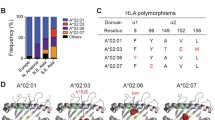Abstract
CYTOTOXIC T cells are important in graft rejection and in the control of virus infections, but the mode of interaction of these cells with their targets, particularly in man remains unclear. It has been shown in mice that products of genes in the major histocompatibility complex (H–2) are involved in these interactions even when the cytotoxic T cells are specific for viral or non-H–2 antigens. This involvement is seen as the requirements that the target cell must express the specific non-H–2 antigen and in addition the same H–2, D or K region antigens as were present on the cells which initiated the immune response1–4. Cytotoxic T cells specific for viral or non-H–2 antigens are thus restricted in the targets that they can kill by the H–2 antigens on the targets. For example, cytotoxic T cells from H–2b female mice suitably primed to the Y antigen of H–2b males, will only kill cells from male mice carrying an H–2D region derived from H–2b (refs 5,6). This report is to our knowledge the first clear demonstration that a similar restriction occurs in man. We describe a situation in man where cytotoxic reactions specific for non-HLA antigens can only occur when target cells carry both the HLA-A2 antigen of the original sensitising cell and the non-HLA target determinant(s). The strong association with maleness suggests that one of the specific antigens involved was coded for by the Y chromosome.
Similar content being viewed by others
References
Zinkernagel, R. M. & Doherty, P. C. Nature 251, 547–548 (1974).
Bevan, M. J. J. exp. Med. 142, 1349–1364 (1975).
Shearer, G. M. Eur. J. Immun. 4, 527–533 (1974).
Zinkernagel, R. M. J. exp. Med. 143, 439–443 (1976).
Gordon, R. D., Simpson, E. & Samelson, L. E. J. exp. Med. 142, 1108–1120 (1975).
Gordon, et al. J. exp. Med. (in the press).
Goulmy, E., Termijtelen, A., Bradley, B. A. & Van Rood, J. J. Tissue Antigens 8, 317–326 (1976).
Van Rood, J. J., Van Leeuwen, A. & Ploem, J. S. Nature 262, 795–797 (1976).
Storb, R., Prentice, R. L. & Thomas, E. J. natn. Cancer Inst. (in the press).
Oliver, R. T. D. Eur. J. Immun. 4, 519–520 (1974).
Author information
Authors and Affiliations
Rights and permissions
About this article
Cite this article
GOULMY, E., TERMIJTELEN, A., BRADLEY, B. et al. Y-antigen killing by T cells of women is restricted by HLA. Nature 266, 544–545 (1977). https://doi.org/10.1038/266544a0
Received:
Accepted:
Issue Date:
DOI: https://doi.org/10.1038/266544a0
- Springer Nature Limited
This article is cited by
-
Y chromosome is moving out of sex determination shadow
Cell & Bioscience (2022)
-
Unrelated cord blood transplantation for adult patients with acute myeloid leukemia: higher incidence of acute graft-versus-host disease and lower survival in male patients transplanted with female unrelated cord blood—a report from Eurocord, the Acute Leukemia Working Party, and the Cord Blood Committee of the Cellular Therapy and Immunobiology Working Party of the European Group for Blood and Marrow Transplantation
Journal of Hematology & Oncology (2015)
-
Clinical impact of H-Y alloimmunity
Immunologic Research (2014)
-
Histocompatibility Y antigen compatibility and allograft rejection in corneal transplantation
Eye (2000)
-
The role of human minor histocompatibility antigens in graft failure: A mini-review
Eye (1995)





